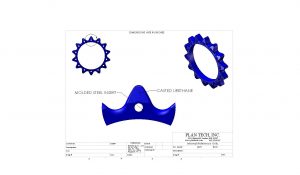Tight tolerance urethane sprockets are an ideal choice of material for the most demanding applications. Plan Tech produces hundreds of thousands of tight tolerance urethane sprockets around the world each year for a wide variety of applications. Most commonly we hear our sprockets drive a track in food processing equipment on large machinery.

Urethane is ideal due to its great ability to absorb an impact and return to its original size even after years of abuse. Tight tolerance polyurethane sprockets will also adapt to any slight mismatch in the operation or any debris that might get caught in between the sprocket and track. Most commonly we have found 50D hardness sprockets will have extended service life with great physical properties. FDA tight tolerance urethane sprockets are also available with additives like PolyMag to make the polyurethane detectable in existing X-ray equipment in case of a failure. Plan Tech can also fabricate any hubbed cores or metal inserts for the complete sprocket. Each metalcore or hub will be media blasted with a coating of chemical bonding adhesive before it is molded to ensure a bond strength greater than the tear strength of the material. Our engineering department can turn your idea, sketch, drawing or CAD file into tight tolerance urethane sprockets.
A couple of different types of casting tight tolerance urethane sprockets are:
Molding Tight Tolerance Urethane Sprockets Compression
The part is split on a parting line, the halves are filled and the material is allowed to gel. The mold is then closed and placed into a compression press.
Advantages: Compression molding yields finished tight tolerance urethane sprockets with detail on all sides. Molds can be more expensive than those used in open casting or transfer, but parts can be quite detailed and elaborate.
Molding Urethane Parts Transfer and Liquid Injection
In transfer or liquid injection, pressure is used to force the liquid polyurethane out of a reservoir and into the mold. Materials are generally injected at the bottom of the part and vented at the top for the prevention of air entrapment.
Advantages: Makes use of fairly low-cost molds and can achieve thin cross-sections. Parts will have a sprue and an open surface for venting air which will require a finishing operation.
Please Contact us for further details or to answer your tight tolerance urethane sprockets design questions!
